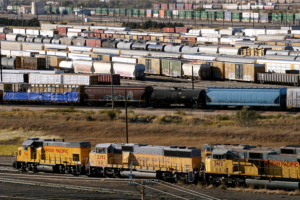 Railways — once the backbone of timely freight shipping — are now strained by bottlenecks, congestion, labor shortages, supply disruptions, and what some classify as exorbitant costs. However, there is change in the wind.
Railways — once the backbone of timely freight shipping — are now strained by bottlenecks, congestion, labor shortages, supply disruptions, and what some classify as exorbitant costs. However, there is change in the wind.
When freight shipping is stalled, it results in a devastating impact on the global supply chain. That impacts everyone … and public officials have been desperate to find remedies. Now, because of a $66 billion allocation in the Bipartisan Infrastructure Law, funding is available to address critical issues related to shipping. And another $3 billion was allocated for public-private partnership efforts that focus on restoring railway reliability.
Some of the upcoming initiatives described in this column are indicative of thousands of additional contracting opportunities that will be announced in the months to come.
The Massachusetts Bay Transportation Authority (MBTA) has allocated $8 million to develop a master plan to improve light rail operations, and the majority of projects being studied focus on resilience. Work will begin this year on a large project to improve resiliency at the High Street facility that serves as the light rail network’s operations control center.
MBTA also has allocated $56 million for improvements to South Station Tower One which houses the system that controls all rail traffic in and out of New England’s second largest multimodal transportation facility. The project scope includes replacing the tower’s existing signal system, upgrading power systems, and replacing generators to accommodate greater demands on the station’s power supply.
Additionally, MBTA is preparing for a project that will expand its existing Codman Yard where a limited number of storage tracks cause disruptions to traffic flow. A $99 million cost estimate is attached to the development of six new storage tracks for MBTA’s Red Line fleet, an upgraded crossover track for seamless rail traffic through the yard, and upgraded signal components.
Department of Transportation officials representing Wisconsin and Minnesota are working together on a major railway connectivity project. The agencies have $31.8 million to use for a collaborative project designed to improve freight operations on a segment of shared route between the Wisconsin cities of La Crosse and Milwaukee. The overall cost of the broader railway improvement effort is expected to reach $53 million as the two states work to develop more diverse and reliable travel options and free up rail lines for dedicated freight shipping.
Local officials in the state of Virginia will use approximately $300 million in federal funding to secure the help of private industry specialists as they expand The Tide, a light rail system in the city of Norfolk. Plans are expected to extend the city’s existing rail line by an additional two miles to build out connectivity. The new direct and expedited routes will help alleviate some of Norfolk’s most stifling congestion. Eventually, existing rail lines will accommodate freight needs and passengers will be diverted to newly constructed routes.
To make light rail freight logistically leaner, the city of Charlotte in North Carolina will spend $39.3 million for technology improvements. This effort will include purchases of server and network refresh equipment, software upgrades, and two-factor security measures for more responsive and efficient shipping operations.
Charlotte also will invest $17.7 million for planning, design, and preliminary construction efforts related to the Transit Corridor System Plan. This initiative will include several projects designed to spur development of new light railways, light rail stations, land acquisition, and complementary infrastructure for other railway innovations. The funding will include redevelopment work on the city’s Silver Line Light Rail, Hambright Park and Ride, and the South End Light Rail Station.
In Illinois, officials are advancing work on a critical railway corridor in the city of Springfield. The 10th Street Rail Improvements Project will shift train traffic away from the city’s congested 3rd Street corridor and redirect it. The project will ultimately consolidate Springfield’s freight and passenger rail traffic and guide its flow through the city with new grade separations and a new passenger rail station. Costs associated with the project are targeted at approximately $315 million.
Alabama’s railroad infrastructure will benefit from a sequence of improvement projects with an estimated total of $231.6 million. Included is an initial $71.6 million phase to build a railway link between the Port of Mobile and a private railroad’s intermodal facility outside the city of Birmingham. The overall plan also will create a 280-mile rail corridor to connect warehousing facilities, economic development sites, and container intermodal terminals across Etowah, Shelby, Washington, and Mobile counties.
Railway infrastructure is a high priority for public officials throughout the country. Upcoming opportunities in this area of commerce will likely continue for at least another decade.






